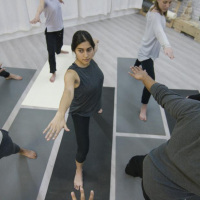
- Musculoskeletal conditions
- Health of older people and improving balance
- Pulmonary conditions
- Cancer
- Cardiovascular disease
- Mental health
- Neurological conditions
- Child health
Access all articles in the Special Collection for free - Cochrane Library Special Collection: Yoga for improving health and well-being.
We asked L Susan Wieland to tell us more about this Special collection:
Your take on what these reviews? What can this Cochrane Special Collection tell us as a whole?
We know that yoga has become extremely popular as an exercise and that many people believe it has benefits for overall wellness. Many people also use yoga as a therapy to help improve specific physical or mental conditions or symptoms, and over the pastdecadesthere have been literally hundreds of trials testing whether yoga is helpful for health. Finding all the relevant trial evidence, assessing this evidence, and putting it all together is what Cochrane excels at. This special collection tells us what areas of yoga therapy Cochrane has concentrated on evaluating during recent years.
What is striking about this Cochrane Special Collection and what it tells us about yoga?
This collection is striking in the range of conditions for which yoga has been tested. It tells us that there is a lot of interest in whether yoga can be helpful in preventing or treating healthconditions,and that there is also a lot of interest in yoga as an additional therapy to help improve the quality of life for people who are managing specific health conditions.
Does it point to the need for more research?
There are definitely gaps in the Cochrane review evidence. For example, there are several reviews on yoga for schizophrenia, but no reviews on yoga for some common mental health conditions such as depression, anxiety and so on. There is a review of yoga for low back pain, but no reviews on yoga for other musculoskeletal conditions such as rheumatoid arthritis, fibromyalgia, osteoarthritis and so on. We know there are high-quality non-Cochrane reviews of yoga for some of these other conditions, but a major plus of Cochrane reviews is that they are regularly updated as new evidence becomes available. This allows the Cochrane reviews to be up to date with the most recent trial evidence, and sometimes even allows the reviews to answer new questions. For example, we published our Cochrane review of yoga for low back pain early this year, and since then at least two additional trials have been published. We are already planning our work to update the Cochrane review, and looking forward to incorporating new trial evidence on the effects of yoga for low back pain in older populations and lower SES populations.
Something that also becomes evident from looking at the individual reviews is that there is often a need for more trial research. Sometimes there is a lot of interest in using yoga for a particular medical condition, and it is promoted online or in classes, but there are only a few small trials testing the effects of yoga for that condition, so we can't tell from the available evidence whether using yoga is actually helpful. Finding that there is a lack of evidence can be quite frustrating for a systematic reviewer, but identifying a need for additional trials and describing how those trials might best be designed and reported can be a major contribution of a systematic review.
Finally, yoga is a complex and variable intervention, and assessing evidence about yoga is very different from assessing evidence about a pharmaceutical drug or surgical technique. Sometimes we see that yoga is helpful, but it isn't clear whether we should or shouldn't expect different yoga interventions to have similar effects. If we see that Iyengar yoga and Viniyoga are helpful, does that mean that Vinyasa or Bikram would also be likely to be helpful? On a more granular level, if a series of yoga interventions with both physical poses and breathing exercisesishelpful, does that mean that the breathing exercises are crucial for the intervention to be beneficial? Or even that a particular type or amount of breathing exercise is necessary? Sometimes the answer is that these details don't seem to matter, but often we just don't know. We need to do additional work as researchers to produce information from trials and systematic reviews that people can use to make practical real-life decisions about using yoga as a therapy.
Does this provide that evidence that yoga helps with general health and well being and what specific conditions really stand out as benefitting?
The reviews are mostly not designed to look for effects on health and well being in the general population. However, there is evidence that yoga is beneficial in specific medical conditions (for example, it stands out that yoga probably has benefits for back function in people with chronic low back pain) and there is also evidence that people with a range of conditions (e.g., asthma, breast cancer) may experience improved quality of life when using yoga.
